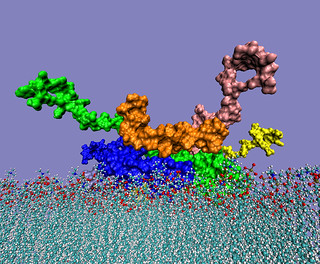Parkinson’s Disease, a neurodegenerative disorder affecting millions worldwide, has long remained a formidable challenge in the medical field. However, recent developments offer a glimmer of hope in the quest for effective treatment. A groundbreaking study led by Gennaro Pagano and his team at Roche Pharmaceuticals sheds light on a potential game-changer: prasinezumab, a drug designed to target the underlying culprit of Parkinson’s – the accumulation of misfolded alpha-synuclein proteins in the brain. Prasinezumab’s effectiveness in targeting misfolded alpha-synuclein proteins in Parkinson’s patients highlights the relevance of protein structure and function, a topic we have covered in class. Alterations in protein structure, such as misfolding, can disrupt normal cellular function and lead to the development of diseases like Parkinson’s.
For years, researchers have recognized the pivotal role of alpha-synuclein in the progression of Parkinson’s disease. This misfolded protein wreaks havoc on dopamine-producing neurons, leading to the hallmark motor symptoms of the condition. While existing treatments aim to alleviate these symptoms by boosting dopamine levels, they fall short in addressing the root cause of the disease. Thus, the need for disease-modifying therapies that can slow or halt Parkinson’s progression remains urgent.
Enter prasinezumab, an innovative antibody engineered to bind to aggregated clumps of misfolded alpha-synuclein. Administered via intravenous infusion, this novel drug holds the potential to disrupt the neurotoxicity caused by alpha-synuclein, impede the spread of pathological aggregates between cells, and ultimately slow disease progression.
The pivotal clinical trial conducted by Pagano and his colleagues recruited 316 individuals with early-stage Parkinson’s disease. Participants received either a placebo or varying doses of prasinezumab over the course of one year. Initial results suggested minimal impact, but upon closer analysis, a ray of hope emerged.
Remarkably, prasinezumab demonstrated significant efficacy in individuals with more severe Parkinson’s symptoms. Those experiencing rapid eye movement sleep behavior disorder, taking MAO-B inhibitor, or rated at stage two on a symptom scale exhibited a notable reduction in the progression of motor symptoms compared to the placebo group.
This promising outcome suggests that prasinezumab may hold particular promise for individuals with rapidly progressing Parkinson’s, characterized by higher levels of misfolded alpha-synuclein in the brain. By potentially clearing these toxic protein aggregates, the drug could offer newfound hope for slowing disease advancement in this vulnerable population.
However, challenges remain on the path to conclusive validation. Critics point out the absence of biomarkers to monitor changes in alpha-synuclein levels within participants’ brains, raising questions about the drug’s disease-modifying effects. Vinata Vedam-Mai of the University of Florida Health highlights the need for longer-term data to assess both the safety and efficacy of prasinezumab comprehensively.
Looking ahead, further research is warranted to explore prasinezumab’s effectiveness in individuals with milder forms of Parkinson’s over extended periods. By exploring its potential across a broader spectrum of disease severity, researchers can unlock valuable insights into the drug’s therapeutic utility.
While the journey towards a definitive Parkinson’s treatment remains ongoing, the strides made with prasinezumab offer a beacon of hope for patients and researchers alike. With continued dedication and scientific inquiry, we inch closer to the elusive goal of transforming Parkinson’s disease from a life-altering diagnosis to a manageable condition. What do you think about the potential of prasinezumab? How do you think this can change the way we see a Parkinson’s diagnosis?



Leave a Reply